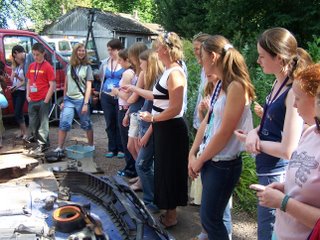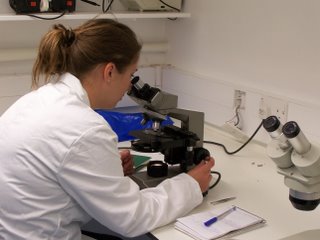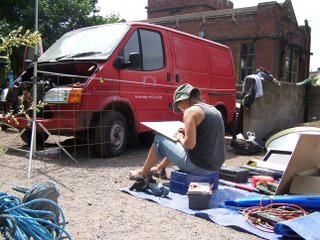Ironbridge Archaeology Van (viii)
We have recieved the third (and possibly final) report from John Schofield at Bristol...
Final days
Excavation of the van is now complete and on Wednesday – with the help of the AA once again – we take the van to Avonmouth for disposal. The last few days have seen physical effort largely replaced by the close inspection of parts, catching up with context sheets, drawing elevations and scientific analyses … with one notable exception: the engine was removed on Friday, and we were finally able to dismantle sections of it and assess its condition. Scientific analysis of the van is now underway. Researchers from the chemistry department have taken samples of seat fabric, door panels and headlining, and dust from behind the facia – they are planning to assess the pollutants the drivers of the van were exposed to. Our own forensic work has involved examining hairs recovered from the floor, while we have been contacted by Exeter University – somebody there wants to examine the bugs we have recovered, from the interior, the air filter and the radiator. This week we have also benefited from discussing our forensic strategy with a Crime Scene Manager from Avon and Somerset Police.
One of the unexpected benefits of our work has been the opportunity to invite comment on contemporary archaeology from passers-by, people who wouldn’t normally have the opportunity to debate such things. Amongst others, we have discussed the project with cleaners, police and security, research and teaching staff from numerous departments at the university, Peter Lee of the Transit Van Club, and a group of summer school students. Most understand the project and see benefit in what we’re doing, making the familiar unfamiliar. We realise this isn’t an opinion shared by all and have welcomed all comments left on the BAJR and Britarch discussion pages.
We now turn our attention to researching the place of origin, date and condition of parts and components, completing the scientific analyses, writing the project report, compiling the archive, and film production. The film will be shown at the forthcoming CHAT conference, at Bristol University, at the Cube on Saturday evening, 11 November.
 Research- ers from the Chemistry depart- ment at the University of Bristol take dust samples for analysis.
Research- ers from the Chemistry depart- ment at the University of Bristol take dust samples for analysis.
 A visit from summer school students.
A visit from summer school students.
 Forensic invest- igation takes place on hairs from the back of the van.
Forensic invest- igation takes place on hairs from the back of the van.
 The elevation drawings are prepared
The elevation drawings are prepared
Final days
Excavation of the van is now complete and on Wednesday – with the help of the AA once again – we take the van to Avonmouth for disposal. The last few days have seen physical effort largely replaced by the close inspection of parts, catching up with context sheets, drawing elevations and scientific analyses … with one notable exception: the engine was removed on Friday, and we were finally able to dismantle sections of it and assess its condition. Scientific analysis of the van is now underway. Researchers from the chemistry department have taken samples of seat fabric, door panels and headlining, and dust from behind the facia – they are planning to assess the pollutants the drivers of the van were exposed to. Our own forensic work has involved examining hairs recovered from the floor, while we have been contacted by Exeter University – somebody there wants to examine the bugs we have recovered, from the interior, the air filter and the radiator. This week we have also benefited from discussing our forensic strategy with a Crime Scene Manager from Avon and Somerset Police.
One of the unexpected benefits of our work has been the opportunity to invite comment on contemporary archaeology from passers-by, people who wouldn’t normally have the opportunity to debate such things. Amongst others, we have discussed the project with cleaners, police and security, research and teaching staff from numerous departments at the university, Peter Lee of the Transit Van Club, and a group of summer school students. Most understand the project and see benefit in what we’re doing, making the familiar unfamiliar. We realise this isn’t an opinion shared by all and have welcomed all comments left on the BAJR and Britarch discussion pages.
We now turn our attention to researching the place of origin, date and condition of parts and components, completing the scientific analyses, writing the project report, compiling the archive, and film production. The film will be shown at the forthcoming CHAT conference, at Bristol University, at the Cube on Saturday evening, 11 November.
 Research- ers from the Chemistry depart- ment at the University of Bristol take dust samples for analysis.
Research- ers from the Chemistry depart- ment at the University of Bristol take dust samples for analysis. A visit from summer school students.
A visit from summer school students. Forensic invest- igation takes place on hairs from the back of the van.
Forensic invest- igation takes place on hairs from the back of the van. The elevation drawings are prepared
The elevation drawings are prepared
